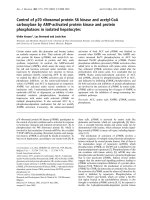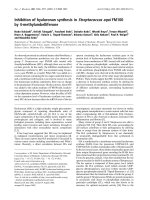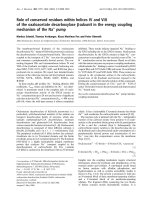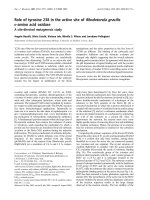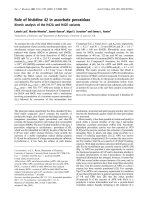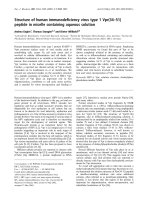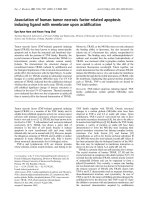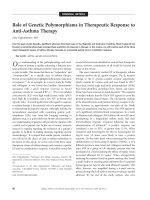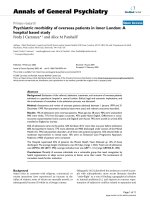Báo cáo y học: " Isolation of human β-defensin-4 in lung tissue and its increase in lower respiratory tract infection" ppt
Bạn đang xem bản rút gọn của tài liệu. Xem và tải ngay bản đầy đủ của tài liệu tại đây (934.16 KB, 9 trang )
BioMed Central
Page 1 of 9
(page number not for citation purposes)
Respiratory Research
Open Access
Research
Isolation of human β-defensin-4 in lung tissue and its increase in
lower respiratory tract infection
Shigehisa Yanagi*
1
, Jun-ichi Ashitani
1
, Hiroshi Ishimoto
2
, Yukari Date
1
,
Hiroshi Mukae
2
, Naoyoshi Chino
3
and Masamitsu Nakazato
1
Address:
1
Third Department of Internal Medicine, Miyazaki University School of Medicine, Miyazaki 889-1692, Japan,
2
Second Department of
Internal Medicine, Nagasaki University School of Medicine, Nagasaki 852-8501, Japan and
3
Peptide Institute, Inc. Osaka 562-8686, Japan
Email: Shigehisa Yanagi* - ; Jun-ichi Ashitani - ;
Hiroshi Ishimoto - ; Yukari Date - ; Hiroshi Mukae - ;
Naoyoshi Chino - ; Masamitsu Nakazato -
* Corresponding author
Abstract
Background: Human β-defensin-4 (hBD-4), a new member of the β-defensin family, was
discovered by an analysis of the genomic sequence. The objective of this study was to clarify hBD-
4 expression in human lung tissue, along with the inducible expression in response to infectious
stimuli, localization, and antimicrobial activities of hBD-4 peptides. We also investigated the
participation of hBD-4 in chronic lower respiratory tract infections (LRTI) by measuring the
concentrations of hBD-4 peptides in human bronchial epithelial lining fluid (ELF).
Methods: The antimicrobial activity of synthetic hBD-4 peptides against E. coli and P. aeruginosa
was measured by radial diffusion and colony count assays. We identified hBD-4 in homogenated
human lung tissue by reverse-phase high-performance liquid chromatography coupled with a
radioimmunoassay (RIA). Localization of hBD-4 was studied through immunohistochemical analysis
(IHC). We investigated the effects of lipopolysaccharide (LPS) on hBD-4 expression and its release
from small airway epithelial cells (SAEC). We collected ELF from patients with chronic LRTI using
bronchoscopic microsampling to measure hBD-4 concentrations by RIA.
Results: hBD-4 exhibited salt-sensitive antimicrobial activity against P. aeruginosa. We detected the
presence of hBD-4 peptides in human lung tissue. IHC demonstrated the localization of hBD-4-
producing cells in bronchial and bronchiolar epithelium. The levels of hBD-4 peptides released from
LPS-treated SAECs were higher than those of untreated control cells. ELF hBD-4 was detectable
in 4 of 6 patients with chronic LRTI, while the amounts in controls were all below the detectable
level.
Conclusion: This study suggested that hBD-4 plays a significant role in the innate immunity of the
lower respiratory tract.
Background
Bronchial epithelial lining fluid (ELF) contains various
antimicrobial substances to protect against pathogenic
insult. The antimicrobial components of the ELF are lys-
Published: 04 November 2005
Respiratory Research 2005, 6:130 doi:10.1186/1465-9921-6-130
Received: 21 July 2005
Accepted: 04 November 2005
This article is available from: />© 2005 Yanagi et al; licensee BioMed Central Ltd.
This is an Open Access article distributed under the terms of the Creative Commons Attribution License ( />),
which permits unrestricted use, distribution, and reproduction in any medium, provided the original work is properly cited.
Respiratory Research 2005, 6:130 />Page 2 of 9
(page number not for citation purposes)
ozyme, lactoferrin, secretory phospholipase-A2, and anti-
microbial peptides, including defensins [1]. Defensins,
which are single-chain, strongly cationic antimicrobial
peptides with a molecular weight of 3,000–4,500, have
broad-spectrum antimicrobial activities against various
Gram-positive and Gram-negative bacteria, mycobacteria,
fungi, and certain enveloped viruses [1]. Defensins are
classified as α-and β-defensins based on the connectivity
of their six cystein residues [1]. Human β-defensins
(hBDs) are expressed mainly in epithelial cells. hBD-1 is
expressed constitutively in the epithelia of the urogenital
tract, trachea, and respiratory tract [2-4]. hBD-2 and hBD-
3, isolated from psoriatic scale extracts [5,6], are expressed
mainly in the respiratory tract, and their expression
increases in response to infections and inflammatory
mediators [6-11]. In addition, these two hBDs show
strong antimicrobial activity against pathogens of respira-
tory infections, including P. aeruginosa, and thus they
seem to function in airway mucosal defense [6-11].
hBD-4, a new member of the β-defensin family, was iden-
tified by analysis of genomic sequence mapping at chro-
mosome 8p23, where all known α- and β-defensins are
clustered [12]. hBD-4 mRNA is expressed in human testis,
stomach, neutrophils, lung, and other organs [12], but
neither hBD-4 peptide expression in human lung tissue
nor its pathophysiological significance in respiratory tract
infections has been clarified. We here studied the role of
hBD-4 in lower respiratory tract infections (LRTI). We
showed the existence, localization, and inducible expres-
sion of hBD-4 in response to infectious stimuli. In addi-
tion, we determined the concentrations of hBD-4 in
human ELF collected by the bronchoscopic microsam-
pling (BMS) method to investigate the significance of
hBD-4 in respiratory tract infections.
Methods
Peptide synthesis
The reduced peptide of hBD-4, designed by García et al.
and composed of 37 amino acid residues, was obtained
by the chemical ligation method [12]. An oxidative fold-
ing reaction of the reduced peptide was carried out in 0.1
M ammonium acetate buffer (pH 7.8) in the presence of
reduced and oxidized glutathione (GSH/GSSG) in a
molar ratio of 1/100/10 (reduced hBD-4/GSH/GSSG) at
4°C overnight. Reversed-phase high-performance liquid
chromatography (RP-HPLC) analysis revealed a single
distinct main product, which was purified by preparative
RP-HPLC on a YMC C18 column and ion-exchange chro-
matography on CM-Sepharose. The peptide thus obtained
was passed through columns of Muromac and then
Sephadex LH-20 to obtain hBD-4 in the acetate form (the
yield of the oxidized peptide was 56% based on the
reduced peptide). The purity of synthetic hBD-4 was con-
firmed to be sufficiently high by RP-HPLC, IEX-HPLC,
capillary zone electrophoresis, amino acid analysis,
sequence analysis, elemental analysis, and matrix-assisted
laser desorption/ionization time-of-flight (MALDI-TOF)
mass spectrometry (observed m/z was 4367.3, theoretical
[M+H]
+
= 4367.0). The synthetic products of hBD-2 and
hBD-3 were purchased from Peptide Institute Inc. (Osaka,
Japan).
Bactericidal assay
Radial diffusion and colony count assays were used to
examine antimicrobial activity [13,14]. We studied the
antimicrobial ability of synthetic hBD-4 as well as hBD-2,
hBD-3, and penicillin G (Sigma, St. Louis, MO, USA) by
radial diffusion assay with E. coli strain HB101 and P. aer-
uginosa strain PAO1 (supplied by T. Hayashi, Department
of Microbiology, Miyazaki University). Briefly, bacteria
were cultured at 37°C overnight in trypticase soy broth
(TSB; Nissui Pharmaceutical Co., Ltd., Tokyo, Japan). An
aliquot of this culture was transferred to fresh TSB and
incubated for 4 h at 37°C to obtain cells in logarithmic-
phase growth. Following the precipitation of bacteria by
centrifugation at 800 × g for 10 min, the samples were
washed with phosphate-buffered saline (PBS) and quanti-
fied spectrophotometrically at 620 nm. A culture volume
containing 1 × 10
6
bacterial colony-forming units (CFU)
was then added to 10 ml warm (40°C) autoclaved PBS
containing 3.0 g of TSB medium and 1% low electroen-
dosmosis-type agarose. After a rapid dispersion of bacte-
ria, the bacteria-containing agar was poured into a plate to
form a uniform layer. Wells measuring 3 mm in diameter
were then created in the agar using a gel punch. After 5 µl
of each control samples and each diluted peptides to each
well, the samples were incubated for 18 h at 37°C. The
antimicrobial activity was taken as the difference between
the size of the clear zone surrounding the wells containing
defensins, penicillin G, and those containing control sam-
ple.
The antimicrobial activities of hBD-2, hBD-3, and hBD-4
were also examined by colony count assay using E. coli
HB101 and P. aeruginosa PAO1. Then, 5000 CFU of bacte-
ria was incubated for 2 h at 37°C with defensin in concen-
trations ranging in tenfold steps from 0.1 to 1000 µg/ml.
The final volume of the incubation medium was 50 µl. To
measure antibacterial activity more precisely, some series
were performed by repeating the analysis with defensin
concentrations that ranged in twofold steps from 0.625 to
40 µg/ml. Since the differences in salt sensitivity in the
antimicrobial activity of hBDs were previously reported
[3,6,7,15], we evaluated the salt sensitivity of the antimi-
crobial activity of the defensins using two incubation
media conditions: 1) a high salt condition (Na
+
137 mEq/
L, Cl
-
130 mEq/L, K
+
4.2 mEq/L, osmolarity 270 mOsm/
kg, pH 7.4) and 2) a low salt condition (Na
+
95 mEq/L, Cl
-
90 mEq/L, K
+
25 mEq/L, osmolarity 210 mOsm/kg, pH
Respiratory Research 2005, 6:130 />Page 3 of 9
(page number not for citation purposes)
7.1). The incubation mixtures were serially diluted, spread
on nutrient agar plates, and incubated for 18 h at 37°C.
The antimicrobial activity was expressed as the colony
reduction ratio, defined as the number of killed bacteria
to that of control bacteria.
Preparation of antiserum
hBD-4 (2.5 mg) was conjugated to bovine thyroglobulin
(15 mg) using 1-ethyl-3-(3-dimethylaminopropyl)-carbo-
diimide HCL (400 mg) as described previously [16], then
dialyzed five times against two liters of 0.9% sodium chlo-
ride to remove unconjugated material. An antigenic con-
jugate solution (0.9–3.0 ml) was used to immunize three
New Zealand white rabbits by multiple intra- and sub-
cutaneous injections. The animals were given booster
shots every 2 weeks, then were bled 7 days after each injec-
tion. All experimental protocols were approved by the
Ethics Review Committee for Animal Experimentation of
Miyazaki University.
Study population
For immunohistochemistry, we obtained human normal
lung tissues from 2 patients at surgery: a 38-year-old
female with pulmonary mucormycosis and a 70-year-old
male with bullae. The patient with mucormycosis also
exhibited insulin-dependent diabetes mellitus, while the
other patient had no complications that induced an
immunosuppressive condition. The patient with
mucormycosis was a smoker, and the other patient was
not. To evaluate the localization of hBD-4 in chronic LRTI,
we also obtained human lung tissue from a 63-year-old
female with middle lobe syndrome.
For radioimmunoassay experiments, 6 controls (2 males
and 4 females, ranging from 30 to 78 years old, 1 smoker
and 5 nonsmokers) and 6 patients (2 males and 4
females, ranging from 64 to 83 years old, all 6 nonsmok-
ers) with chronic LRTI who had persistent productive
cough with purulent sputum for more than 6 months
were enrolled in this study. The following exclusion crite-
ria were adopted for the patient group: (i) steroids, immu-
nosuppressive drugs, or any antibiotics prescribed within
3 months; (ii) cancer or diabetes mellitus. The pathogens
of patients with chronic LRTI consisted of the mucoid
phenotype of P. aeruginosa in 3 cases and the nonmucoid
phenotype of P. aeruginosa in 3 cases. The controls under-
went bronchoscopy to identify the causes of small solitary
peripheral nodules. The final diagnoses of the controls
consisted of the healing stage of pulmonary suppuration
in 1 case and lung nodule of unidentified etiology in 5
cases. According to the results of the histological study,
laboratory data, clinical course, and radiological findings
including positron emission tomography, we confirmed
strongly that the pulmonary diseases in the 6 controls
were all benign. In the controls, no bacterial compounds
were detected in samples obtained from the respiratory
tract. All controls and patients gave written informed con-
sent to participate in the study, which was approved by
the Research Ethics Committee of Miyazaki University.
Immunohistochemical study
Normal lung tissues from the 2 patients mentioned
above, as well as lung tissues with chronic LRTI from a 63-
year-old female with middle lobe syndrome, were
obtained at surgery for immunohistochemical study. The
tissues were fixed in 3.7% formaldehyde in 10 mM PBS
(pH 7.2), dehydrated in a graded ethanol series, and
embedded in paraffin. Cut sections (3 µm thick) were
deparaffinized in xylene, rehydrated in a graded ethanol
series, and then washed in Tris-buffered saline containing
Tween 20 (TBST; DakoCytomation Co., Ltd., Kyoto,
Japan). For antigen retrieval, the sections were incubated
in 1 µg/ml proteinase K (DakoCytomation) for 30 min at
37°C and treated with 6% hydrogen peroxidase for 60
min to inactivate endogenous peroxidases. Nonspecific
binding was inhibited by an incubation in Protein Block
(DakoCytomation) for 3 h at 37°C. Preparations were
incubated overnight at 4°C with anti-hBD-4 antiserum at
a final concentration of 1/10000. Staining was visualized
using the Dako CSA system (DakoCytomation) according
to the manufacturer's protocol. Control studies utilized
normal rabbit serum or anti-hBD-4 antiserum that had
been pre-absorbed with 1 µg hBD-4.
Radioimmunoassay (RIA) procedure
hBD-4 was radioiodinated by the lactoperoxidase method
[17]. The
125
I-labeled peptide was purified by RP-HPLC
using a TSK ODS 120A column (Tosoh Co., Ltd., Tokyo,
Japan). RIA reaction mixtures were incubated in 50 mM
sodium phosphate (pH 7.4) containing 0.25% N-ethyl-
maleimide-treated BSA, 80 mM NaCl, 25 mM EDTA·2Na,
0.05% NaN3, 0.1% Triton X-100, and 3.1% Dextran T-40.
Diluted samples or standard peptide solutions (100 µl)
were incubated for 24 h in 100 µl of antiserum no. 1–4
(final concentration: 1/2,100,000). A solution of the
tracer, 16,000–18,000 cpm of
125
I-labeled peptide in 100
µl reaction buffer, was then added. After 24 h incubation,
normal rabbit serum and anti-rabbit IgG goat serum were
added for an additional 12 h incubation. Bound and free
ligands were separated by centrifugation. All procedures
were performed at 4°C. Samples were assayed in dupli-
cate. In the RIA for hBD-4, antiserum no. 1–4 recognized
hBD-4 with high affinity at final dilutions of 1/2,100,000
(35% binding). Half-maximum inhibition occurred at 7
pg/tube. The peptide remained detectable at the low level
of 0.7 pg/tube. At 50% binding, the respective intra- and
inter-assay coefficients of variation were 3.9% and 4.2%.
This antiserum did not exhibit any cross-reactivity for
human neutrophil peptide-1, hBD-1, hBD-2, or hBD-3.
Respiratory Research 2005, 6:130 />Page 4 of 9
(page number not for citation purposes)
Chromatographic characterization of immunoreactive
hBD-4 in lung
Normal human lung tissue, isolated as described above
for immunohistochemical studies, was heated at 95–
100°C for 10 min in a 10-fold volume of water to inacti-
vate intrinsic proteinases. After cooling to 4°C,
CH
3
COOH and HCL were added at final concentrations
of 1 M and 20 mM, respectively. Following homogeniza-
tion in a Polytron for 15 min, the homogenate was centri-
fuged at 18,500 × g for 30 min at 4°C. The resulting
supernatant was applied to a Sep-Pak C-18 cartridge
(Waters, Milford, MA, USA) pre-equilibrated in 0.5 M
CH
3
COOH. Peptides were eluted in 35% acetonitrile
(CH
3
CN) containing 0.1% trifluoroacetic acid (TFA). The
eluate was examined by RP-HPLC on a TSK ODS SIL 120A
(Tosoh Co. Ltd., Tokyo, Japan) column using a linear gra-
dient of 10–35% CH
3
CN containing 0.1% TFA at a rate of
1.0 ml/min for 40 min. All fractions were assayed for
hBD-4 by RIA.
Cell culture and induction of hBD-4 expression
Small airway epithelial cells (SAECs) were purchased from
Clonetics and grown to monolayers in tissue culture flasks
at 37°C in a 5% CO
2
-humidified atmosphere. SAECs were
maintained in SAGM (Cambrex Bioscience Walkersville,
Inc., Walkersville, MD, USA). Hydrocortisone and bovine
serum albumin were removed from this medium before
treatment with stimulants and during the time of the
study. All experiments were performed between the third
and fifth passages.
For the analysis of hBD-4 peptide expression and release,
SAECs were grown in a 175 cm
2
flask (Falcon). When 70–
80% confluence was reached, SAECs were incubated for
24 h with culture medium alone (control) or medium
containing 100 µg/ml P. aeruginosa-derived lipopolysac-
charide (LPS). After stimulation, 70 ml of each medium
(derived from approximately 5 × 10
7
SAECs) was collected
and centrifuged (3500 rpm, 30 min), then the superna-
tants were transferred to a new tube and stored at -20°C
until use. The cells were washed twice with cold PBS. Then
10 ml of PBS was added to the flask, and the cells were
scraped and collected into a centrifuge tube. After centrif-
ugation (3500 rpm, 30 min), the PBS was aspirated off.
The cell pellet was frozen in liquid nitrogen, weighed, and
heated at 95–100°C for 10 min in a tenfold volume of
water to inactivate intrinsic proteases. After cooling to
4°C, CH
3
COOH and HCL were added to the respective
final concentrations of 1 M and 20 mM, after which the
cell pellet was homogenized in a Polytron for 10 min. The
homogenate was centrifuged at 18,500 × g for 30 min at
4°C. Both supernatants and extracts from the cells were
applied to a Sep-Pak C-18 cartridge pre-equilibrated in 0.5
M CH
3
COOH. The peptides were eluted in 35% ace-
tonitrile (CH
3
CN) containing 0.1% trifluoroacetic acid
(TFA). The eluate was lyophilized, and the residue was
dissolved in 0.1 M sodium phosphate buffer (pH 7.4)
containing 0.05% Triton X-100. The peptides were then
measured by RIA for hBD-4.
Bronchoscopic microsampling of ELF
Using the BMS method, we obtained ELF from patients
with chronic LRTI and controls to measure the concentra-
tions of hBD-4. The BMS probe (Olympus Co., Tokyo,
Japan) and sampling procedure were described previously
[18]. In brief, after routine premedication, a flexible BF-
XT40 fiberoptic bronchoscope (Olympus) was inserted
into the lungs. After flushing with air to minimize con-
tamination of the samples, the BMS probe was inserted
through the channel into the right lower lobe bronchus.
Then the inner probe was advanced slowly into the distal
airway, and ELF was sampled by placing the probe gently
at a site on the target bronchial wall for 10 seconds. The
inner probe was withdrawn into the outer tube, and both
devices were withdrawn simultaneously. The wet inner
probe was sectioned 2 cm from its tip. Three sectioned
probes at one time point from each subject were placed in
a preweighed tube and weighed. A dilute solution was pre-
pared by adding 3 ml of saline to the tube and vortexing
it for 1 min. The solution was transferred to a new tube
and stored at -20°C until use. The probe was then dried
and weighed again to measure the ELF volume. The saline-
diluted sample (3 ml) was applied to a Sep-Pak C-18 car-
tridge pre-equilibrated in 0.5 M CH
3
COOH. Adsorbed
peptides were eluted in 35% CH
3
CN containing 0.1%
TFA. The eluate was lyophilized and assayed by hBD-4-
specific RIA. The concentrations of hBD-4 in ELF (hBD-
4
ELF
) were determined as follows:
hBD-4
ELF
= hBD-4
BMS
× (3 + ELF volume) / ELF volume,
where hBD-4
BMS
is the measured concentration of hBD-4
in the saline-diluted sample. We also assayed the serum
concentrations of hBD-4 in both groups. A serum sample
(1 ml) of each groups was collected just before the ELF
was obtained. Both ELF and the serum were applied to a
Sep-Pak C-18 cartridge pre-equilibrated in 0.5 M
CH
3
COOH. Adsorbed peptides were eluted in 35%
CH
3
CN containing 0.1% TFA. The eluate was lyophilized
and assayed by hBD-4-specific RIA.
Statisitical analysis
Data were expressed as means ± standard deviations (SD).
Differences between groups were examined using the
analysis of variance (ANOVA) and Scheffe's test. A p value
of < 0.05 was considered statistically significant.
Respiratory Research 2005, 6:130 />Page 5 of 9
(page number not for citation purposes)
Results
Antimicrobial activity of hBD-4
We performed a radial diffusion assay with synthesized
defensins and penicillin G. hBD-4 exhibited dose-
dependent antimicrobial activity, and this activity was
stronger against P. aeruginosa than against E. coli (Fig. 1).
The antimicrobial activity of hBD-4 against P. aeruginosa
was stronger than that of hBD-2. We next studied the anti-
microbial activity of hBD-4 by a colony count assay under
two different electrolyte concentrations (Table 1). Under
the low salt condition (Na
+
95 mEq/L, Cl
-
90 mEq/L, K
+
25
mEq/L, osmolarity 210 mOsm/kg, pH 7.1), the concen-
tration of hBD-4 at which the population of E. coli colony
was reduced by 50% was 9.1 ± 3.5 µg/ml, which was
higher than that for hBD-2 (1.1 ± 0.7 µg/ml). In contrast,
hBD-4 had an antimicrobial effect as strong as those of
hBD-2 and hBD-3 (1.0 ± 0.5 µg/ml and 0.6 ± 0.2 µg/ml,
respectively) against P. aeruginosa under the low salt con-
dition (1.3 ± 0.6 µg/ml). The antimicrobial activity of
hBD-4, like that of hBD-2, decreased under the high salt
condition (Na
+
137 mEq/L, Cl
-
130 mEq/L, K
+
4.2 mEq/L,
osmolarity 270 mOsm/kg, pH 7.4), although the activity
of hBD-3 did not change substantially under these two
conditions.
Identification of hBD-4 peptide in the lung
In the two normal lung samples examined, hBD-4-immu-
noreactive cells were diffusely observed in the bronchial
and bronchiolar epithelium (Fig. 2A and 2B, respectively).
Airway epithelial cells showed strong and granular cyto-
plasmic immunostaining. hBD-4 immunoreactivity was
not detected in alveolar epithelial cells (Fig. 2C). Tissue
immunoreactivity was abrogated by preabsorption of the
antiserum with 1 µg/ml hBD-4 peptide (Fig. 2D). Immu-
noreactive hBD-4 was also identified in the human lung
by RP-HPLC combined with RIA (Fig. 3). hBD-4-immu-
noreactive peaks in the samples were eluted at the same
position as the synthetic hBD-4 peptide. We also per-
formed immunohistochemical analysis obtained from
one patient with chronic LRTI. Bronchial epithelial cells
showed strong and granular cytoplasmic immunostaining
(Fig. 4A). Additionally, hBD-4 immunoreactivity was
detected in neutrophils and suppurative exudates within
the bronchial lumen (Fig. 4B).
Induction of hBD-4 peptides from lung epithelial cells by
LPS in vitro
We next assessed whether or not infectious stimuli up-reg-
ulate the release of hBD-4 peptide in bronchial epithelial
cells in vitro. Figure 5 shows the hBD-4 peptide concentra-
tions in the supernatant of SAECs incubated for 24 h with
medium alone or with 100 µg/ml of P. aeruginosa-derived
LPS. The concentrations of hBD-4 peptide released from
LPS-treated SAECs were higher than those of untreated
control cells (P <0.05). Moreover, there was little content
of hBD-4 peptide in either the untreated or LPS-treated
SAECs (data not shown).
Antimicrobial activities of hBD-2 (open circles), hBD-3 (closed circles), hBD-4 (open squares), and penicillin G (closed squares)Figure 1
Antimicrobial activities of hBD-2 (open circles), hBD-
3 (closed circles), hBD-4 (open squares), and penicil-
lin G (closed squares). (A) E. coli HB101, (B) P. aeruginosa
PAO1. An increase in zone size represents the zone size
measured at each antimicrobial compound concentration
minus the zone size of the central control well (3 mm). Data
represent the means ± SD of three independent experi-
ments.
Table 1: Concentration of human β defensins effective in reducing 50% colony of bacteria.
MIC (µg/ml)
hBD-2 hBD-3 hBD-4
Organism H-salt L-salt H-salt L-salt H-salt L-salt
E. coli 26.6 ± 7.6 1.1 ± 0.7 5.7 ± 2.6 4.1 ± 0.8 147 ± 31 9.1 ± 3.5
P. aeruginosa 11.6 ± 1.6 1.0 ± 0.5 0.6 ± 0.2 0.6 ± 0.2 >500 1.3 ± 0.6
The bacteria were incubated with defensin in concentrations ranging tenfold in steps from 0.1 to 1000 µg/ml. To measure antibacterial activity more
precisely, some values were determined by repeating the analysis with defensin concentrations that ranged in twofold steps from 0.625 to 40 µg/ml.
Two incubation media conditions were tested: H-salt was a high salt condition (Na
+
137 mEq/L, Cl
-
130 mEq/L, K
+
4.2 mEq/L, osmolarity 270
mOsm/kg, pH 7.4), and L-salt was a low salt condition (Na
+
95 mEq/L, Cl
-
90 mEq/L, K
+
25 mEq/L, osmolarity 210 mOsm/Kg, pH 7.1). Values
represent the means ± SD of three experiments. (MIC: minimum inhibitory concentration)
Respiratory Research 2005, 6:130 />Page 6 of 9
(page number not for citation purposes)
hBD-4 levels in ELF in patients with chronic LRTI
Since β-defensins are expressed constitutively or inducibly
in response to infection, we measured the ELF and serum
concentrations of hBD-4 in patients with chronic LRTI
and controls. ELF hBD-4 was detectable in 4 of 6 patients
with chronic LRTI, while the amounts in the controls were
all below the detectable level (Fig. 6). The mean ELF con-
centration of hBD-4 in patients with chronic LRTI was
181.6 pg/ml (range, 0 to 380 pg/ml). All 3 patients
infected with the mucoid phenotype of P. aeruginosa
demonstrated high ELF concentrations of hBD-4, while
hBD-4 was not detectable in the ELF of 2 of the 3 patients
infected with the nonmucoid phenotype. The serum hBD-
4 concentrations of both groups were below the detecta-
ble level (data not shown).
Discussion
The present study indicates that hBD-4 plays a significant
role in the innate immunity of the lower respiratory tract.
The strong antimicrobial activity of hBD-4 against P. aer-
Immunohistochemical study of hBD-4 expression in the human lungFigure 2
Immunohistochemical study of hBD-4 expression in the human lung. For each pair of images, the upper panels (A1,
B1, and C1) are the results of the immunohistochemical study of the lung tissue obtained from a 38-year-old female with pul-
monary mucormycosis, and the lower panels (A2, B2, and C2) are those obtained from a 70-year-old male with bullae. Immu-
noreactive cells are present around the bronchial surface (A1, A2) and bronchiolar surface (B1, B2). hBD-4 immunoreactivity is
not detected in alveolar epithelial cells (C1 and C2). No immunoreactivity is detected in tissues following preadsorption of
antiserum with 1 µg/ml hBD-4 peptide (D). The bar represents a length of 50 µm in all panels.
Respiratory Research 2005, 6:130 />Page 7 of 9
(page number not for citation purposes)
uginosa rather than against E. coli, along with its stronger
antimicrobial activity relative to that of hBD-2, under-
scores the deep involvement of hBD-4 in the innate
immunity of the lower respiratory tract. The localization
of hBD-4 and other hBD peptides in the bronchial and
bronchiolar epithelium also supports that they contribute
to the mucosal defenses of the lung [6,7,9,11,15]. We here
demonstrated that hBD-4 is induced in the ELF of patients
with chronic LRTI, making this study the first investiga-
tion of antimicrobial peptide expression in the human
respiratory tract in vivo. In the present study, the ELF hBD-
4 concentrations were not high enough to suppress bacte-
rial proliferation in any patients with respiratory tract
infections. However, hBD-4 acts synergistically with lys-
ozyme [12], which is released from neutrophils in P. aer-
uginosa infections [19]. Moreover, hBD-4 is found to have
a strong additive effect with hBD-3 [12]. Together, these
findings indicate that hBD-4 collaborates with other anti-
microbial substances to defend the airway mucosa against
P. aeruginosa infections.
hBD-4 exhibited salt-sensitive antimicrobial activity. All
defensins are strongly cationic, which facilitates their
interaction with bacteria and allows the formation of mul-
timeric pores within the negatively charged cell mem-
brane [7]. Previous reports show that the antimicrobial
activities of desalted ELF obtained from both cystic fibro-
sis (CF) and normal xenografts were higher than that of
crude ELF obtained from their xenografts. This suggests
that high NaCl concentrations inactivate defensin antimi-
crobial activity by weakening the electrostatic interactions
between defensins and the cytoplasmic membrane [20].
The salt sensitivity of hBD-4 strengthens the concept that
inactivation of these peptides is one of the major factor in
recurrent airway infections in patients with CF.
Compared with the localization of hBD-4 within the cyto-
plasm of airway epithelial cells in normal lung tissues,
hBD-4 immunostaining in lung tissue of chronic LRTI was
observed in the bronchial lumen as well as in the cyto-
plasm of epithelial cells. Also, IHC and ELF findings sug-
gested there was no spontaneous release of hBD-4 into the
airway from epithelial cells in the absence of any infec-
tious stimuli. Hence, there is a possibility that hBD-4 in
the ELF of the controls was present in amounts too small
to be detected. The controls selected here for RIA were not
completely healthy. However, pulmonary diseases that
are known to induce the expression of defensins, such as
malignant diseases, were excluded from the controls.
hBD-4 was thought to be released in response to specific
stimulation such as infection.
The high hBD-4 levels in supernatant, combined with lit-
tle content of hBD-4 in LPS-treated SAECs after 24 h,
means that SAECs biosynthesized hBD-4 only after being
stimulated and released promptly into the extracellular
space. It remains unknown whether a direct or indirect
action of P. aeruginosa is responsible for the biosynthesis
and release of hBD-4. Previous reports show that P. aeru-
ginosa up-regulates hBD-4 mRNA expression in SAECs
[12], but there is a possibility that these phenomena occur
indirectly via cytokines produced from airway epithelial
cells. However, inflammatory cytokines such as IL-1α, IL-
6, interferon-γ, and TNF-α did not induce up-regulation of
hBD-4 mRNA expression in SAECs [12]. Therefore, further
Immunohistochemical study of hBD-4 expression in patients with chronic lower respiratory tract infectionFigure 4
Immunohistochemical study of hBD-4 expression in
patients with chronic lower respiratory tract infec-
tion. hBD-4 immunoreactivity presented in bronchial epithe-
lial cells (A), neutrophils and suppurative exudates within
bronchial lumen (B). The bar represent a length of 50 µm in
(A, B).
Representative RP-HPLC profiles of hBD-4 immunoreactivityFigure 3
Representative RP-HPLC profiles of hBD-4 immuno-
reactivity. Samples were obtained from 300 mg human lung
tissue. Fraction volumes of 0.5 ml were obtained by RP-
HPLC using a TSK ODS SIL 120A (4.6 Å × 150 mm) column
and a linear gradient of 10–60% CH
3
CN containing 0.1% TFA
at a rate of 1.0 ml/min for 40 min. Arrows indicate the elu-
tion position of synthetic hBD-4. "ir-hBD-4" on the Y-axis
means immunoreactive hBD-4.
Respiratory Research 2005, 6:130 />Page 8 of 9
(page number not for citation purposes)
investigation is needed to clarify the mechanism underly-
ing these phenomena.
Interestingly, the ELF in all patients infected with the
mucoid phenotype of P. aeruginosa demonstrated high
hBD-4 concentrations, while hBD-4 was not detectable in
the ELF of 2 of the 3 patients infected with the nonmucoid
phenotype. The high hBD-4 levels in ELF may have origi-
nated from airway epithelial cells and neutrophils in
chronic LRTI, since hBD-4 immunoreactivity was also
detected in neutrophils. However, the high hBD-4 levels
in ELF could not be explained solely by neutrophilsmedi-
ated inflammation because of a significant difference
between the mucoid and nonmucoid phenotypes of P.
aeruginosa. A difference in hBD expression in response to
P. aeruginosa between the mucoid and nonmucoid pheno-
types has also been shown in hBD-2 in vitro [10]. The
mucoid phenotype of P. aeruginosa may contain unique
signaling molecules that stimulate respiratory epithelial
cells for the production of hBDs. hBD-2 exhibits cytotoxic
effects at >50 µg/ml concentrations against airway epithe-
lial cells in vitro [21]. And colonization of the mucoid phe-
notype of P. aeruginosa in the respiratory tracts has been
related to the progression of bronchial airway pathology
[19]. Although it remains uncertain whether or not hBD-
4 is cytotoxic to airway epithelial cells, the mucoid pheno-
type of P. aeruginosa can damage the respiratory tracts
both directly and via the release of hBDs from bronchial
epithelial cells.
The expression of hBD-4 and the release of hBD-4 from
bronchial epithelial cells are both up-regulated in
response to infectious stimuli [12], while hBD-1 is consti-
tutively expressed in the absence of infectious stimulation
[9]. Interestingly, hBD-4 immunoreactivity is not detected
in alveolar epithelial cells where hBD-2 is expressed [22].
Furthermore, hBD-4 has specific signal pathways; hBD-4
induction is mediated by protein kinase C, but not by NF-
κB or STAT, which are associated with up-regulation of
hBD-2 and hBD-3, respectively [11,12,23]. In the present
study, hBD-4 as well as hBD-2 exhibited salt-sensitive
antimicrobial activity, whereas hBD-3 did not. Finally,
Epithelial lining fluid levels of hBD-4 in controls (n = 6) and patients with chronic lower respiratory tract infection (n = 6)Figure 6
Epithelial lining fluid levels of hBD-4 in controls (n =
6) and patients with chronic lower respiratory tract
infection (n = 6). In the CLRTI group, open circles indicate
patients infected with the mucoid phenotype of P. aeruginosa,
and closed circles indicate patients infected with the nonmu-
coid phenotype of P. aeruginosa. The horizontal bar repre-
sents the mean value. (CLRTI: chronic lower respiratory
tract infection, ELF: epithelial lining fluid)
Expression profiles of hBD-4 SAECsFigure 5
Expression profiles of hBD-4 SAECs. hBD-4 peptide
concentrations in supernatants of SAECs after 24 h incuba-
tion with medium alone (control; open bars), and 100 µg/ml
of LPS (solid bar). Values represent the means ± SD of three
experiments. (SAECs: small airway epithelial cells, LPS:
lipopolysaccharide)
Respiratory Research 2005, 6:130 />Page 9 of 9
(page number not for citation purposes)
although the members of the hBD peptide family have
similar amino acid structures, hBD-4 is suggested to play
a different role than the other hBDs in the defense against
respiratory tract infections.
The hBD-4 peptide exhibited strong antimicrobial activi-
ties against P. aeruginosa, which is the most virulent pul-
monary pathogen because of its intrinsic resistance to
multiple classes of antibiotics [24,25]. Antimicrobial pep-
tides have many of the desirable features of a novel anti-
biotic class. They have a broad spectrum of activity, kill
bacteria quickly, are unaffected by classical antibiotic
resistance mutations, and have selective toxicity.
Although further investigation is required, including in
vivo study, hBD-4 may be an attractive candidate for a new
therapeutic agent against P. aeruginosa infection.
Conclusion
hBD-4 plays a significant role in the innate immunity of
the lower respiratory tract. Further molecular analyses of
hBD-4 activity will provide a better understanding of the
physiological role and pathophysiological significance of
this molecule in respiratory infectious disease.
Competing interests
The author(s) declare that they have no competing inter-
ests.
Authors' contributions
SY evaluated the antimicrobial activity of peptides, per-
formed immunohistochemical study, cultured the SAECs,
did the BMS, drafted the manuscript, and participated in
the design of the study. HI prepared antiserum, estab-
lished RIA, and performed RP-HPLC. CN synthesized
hBD-4 peptide. JA, YD, HM, and NM conceived the study
and helped to draft the manuscript. All authors read and
approved the manuscript.
Acknowledgements
The authors wish to thank Dr. K. Toshinai, Dr. T. Simbara, Dr. M.S. Mondal,
and Dr. T. Kawagoe of the Miyazaki University School of Medicine, Japan,
for their invaluable advice in the experiment on antimicrobial activities, RIA,
and cell culture. We also would like to thank S. Tajiri for her excellent tech-
nical assistance. This study was supported in part by the 21st Century COE
Program.
References
1. Bals R: Epithelial antimicrobial peptides in host defense against infec-
tion. Respir Res 2000, 1:141-150.
2. Bensch KW, Raida M, Mägert HJ, Schulz-Knappe P, Forssmann WG:
hBD-1: a novel β-defensin from human plasma. FEBS Lett 1995,
368:331-335.
3. Valore EV, Park CH, Quayle AJ, Wiles KR, McCray PB Jr, Ganz T:
Human β-defensin-1: An antimicrobial peptide of urogenital
tissues. J Clin Invest 1998, 101:1633-1642.
4. Zhao C, Wang I, Lehrer RI: Widespread expression of beta-
defensin hBD-1 in human secretory glands and epithelial
cells. FEBS Lett 1996, 396:319-322.
5. Harder J, Bartels J, Christophers E, Schröder JM: A peptide antibi-
otic from human skin. Nature 1997, 387:861.
6. Harder J, Bartels J, Christophers E, Schröder JM: Isolation and
characterization of human β-defensin-3, a novel human
inducible peptide antibiotic. J Biol Chem 2001, 276:5707-5713.
7. Bals R, Wang X, Wu Z, Freeman T, Bafna V, Zasloff M, Wilson JM:
Human β-defensin 2 is a salt-sensitive peptide antibiotic
expressed in human lung. J Clin Invest 1998, 102:874-880.
8. Hiratsuka T, Nakazato M, Date Y, Ashitani J, Minematsu T, Chino N,
Matsukura S: Identification of human β-defensin-2 in respira-
tory tract and plasma and its increase in bacterial pneumo-
nia. Biochem Biophys Res Commun 1998, 249:943-947.
9. Singh PK, Jia HP, Wiles K, Hesselberth J, Liu L, Conway BA, Green-
berg EP, Valore EV, Welsh MJ, Ganz T, Tack BF, McCray PB Jr: Pro-
duction of β-defensins by human airway epithelia. Proc Natl
Acad Sci USA 1998, 95:14961-14966.
10. Harder J, Meyer-Hoffert U, Teran LM, Schwichtenberg L, Bartels J,
Maune S, Schröder JM: Mucoid Pseudomonas aeruginosa, TNF-α,
and IL-1β, but not IL-6, induce human β-detensin-2 in respi-
ratory epithelia. Am J Respir Cell Mol Biol 2000, 22:714-721.
11. García JR, Jaumann F, Schulz S, Krause A, Rodríguez-Jiménez J, Forss-
mann U, Adermann K, Klüver E, Vogelmeier C, Becker D, Hedrich R,
Forssmann WG, Bals R: Identification of a novel, multifunc-
tional β-defensin (human β-defensin 3) with specific antimi-
crobial activity. Its interaction with plasma membranes of
Xenopus oocytes and the induction of macrophage chem-
oattraction. Cell Tissue Res 2001, 306:257-264.
12. García JR, Krause A, Schulz S, Rodríguez-Jiménez FJ, Klüver E, Ader-
mann K, Forssmann U, Frimpong-Boateng A, Bals R, Forssmann WG:
Human β-defensin 4: a novel inducible peptide with a specific
salt-sensitive spectrum of antimicrobial activity. FASEB J 2001,
15:1819-1821.
13. Takemura H, Kaku M, Kohno S, Hirakata Y, Tanaka H, Yoshida R,
Tomono K, Koga H, Wada A, Hirayama T, Kamihira S: Evaluation
of susceptibility of gram-positive and -negative bacteria to
human defensins by using radial diffusion assay. Antimicrob
Agents Chemother 1996, 40:2280-2284.
14. Harwig SS, Ganz T, Lehrer RI: Neutrophil defensins: purification,
characterization, and antimicrobial testing. Methods Enzymol
1994, 236:160-172.
15. Goldman MJ, Anderson GM, Stolzenberg ED, Kari UP, Zasloff M, Wil-
son JM: Human β-defensin-1 is a salt-sensitive antibiotic in
lung that is inactivated in cystic fibrosis. Cell 1997, 88:553-560.
16. Miyata A, Kangawa K, Toshimori T, Hatoh T, Matsuo H: Molecular
forms of atrial natriuretic polypeptides in mammalian tis-
sues and plasma. Biochem Biophys Res Commun 1985, 129:248-255.
17. Miyata A, Mizuno K, Minamino N, Matsuo H: Regional distribution
of adrenorphin in rat brain: comparative study with PH-8P.
Biochem Biophys Res Commun 1984, 120:1030-1036.
18. Ishizaka A, Watanabe M, Yamashita T, Ogawa Y, Koh H, Hasegawa N,
Nakamura H, Asano K, Yamaguchi K, Kotani M, Kotani T, Morisaki H,
Takeda J, Kobayashi K, Ogawa S: New bronchoscopic microsam-
ple probe to measure the biochemical constituents in epi-
thelial lining fluid of patients with acute respiratory distress
syndrome. Crit Care Med 2001, 29:896-898.
19. Fick RB Jr, Sonoda F, Hornick DB: Emergence and persistence of
Pseudomonas aeruginosa in the cystic fibrosis airway. Semin
Respir Infect 1992, 7:168-178.
20. Bals R, Weiner DJ, Meegalla RL, Accurso F, Wilson JM: Salt-inde-
pendent abnormality of antimicrobial activity in cystic fibro-
sis airway surface fluid. Am J Respir Cell Mol Biol 2001, 25:21-25.
21. Sakamoto N, Mukae H, Fujii T, Ishii H, Yoshioka S, Kakugawa T, Sug-
iyama K, Mizuta Y, Kadota J, Nakazato M, Kohno S: Differential
effects of α- and β-defensin on cytokine production by cul-
tured human bronchial epithelial cells. Am J Physiol Lung Cell Mol
Physiol 2005, 288:L508-513.
22. Hiratsuka T, Mukae H, Iiboshi H, Ashitani J, Nabeshima K, Minematsu
T, Chino N, Ihi T, Kohno S, Nakazato M: Increased concentra-
tions of human β-defensins in plasma and bronchoalveolar
lavage fluid of patients with diffuse panbronchiolitis. Thorax
2003, 58:425-430.
23. Diamond G, Kaiser V, Rhodes J, Russell JP, Bevins CL: Transcrip-
tional regulation of β-defensin gene expression in tracheal
epithelial cells. Infect Immun 2000, 68:113-119.
24. Kollef MH: Gram-negative bacterial resistance: evolving pat-
terns and treatment paradigms. Clin Infect Dis 2005:85-88.
25. Cunha BA: Nosocomial pneumonia. Diagnostic and therapeu-
tic considerations. Med Clin North Am 2001, 85:79-114.
